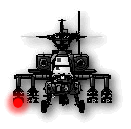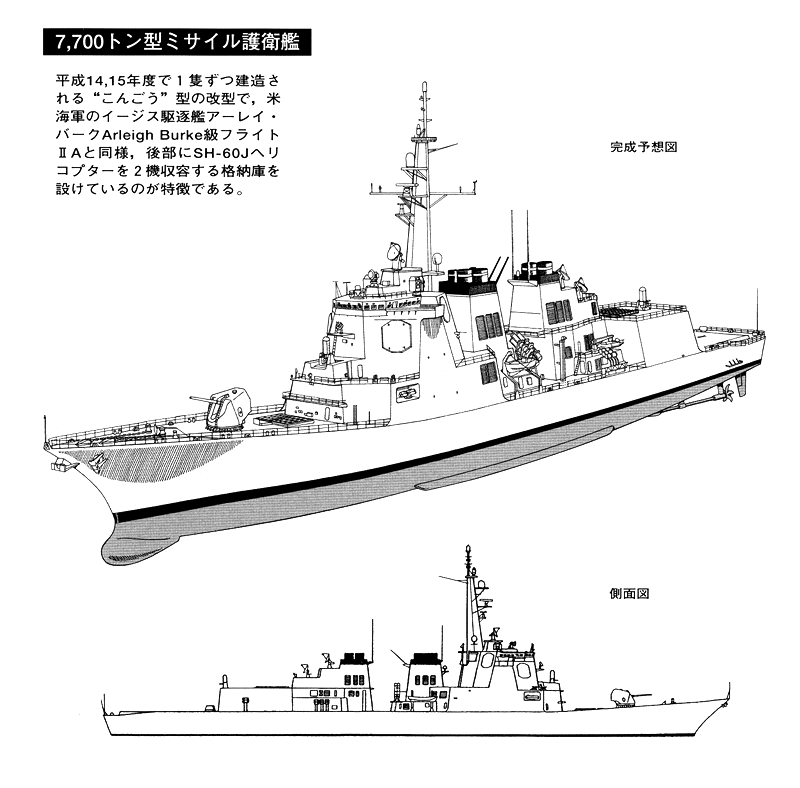
The Kongo Type is the 4th generation guided missile destroyer (DDG) and has a different appearance and contents from previous Japanse DDG designs. The largest size among DDG and SPY-1D AEGIS radars equipped on the four faces of the bridge prove a capacity of this type. This class of four ships is complete, and assigned to 4 escort flotillas as the core ship.
The JMSDF maintains four Escort Flotilla, with each composed of 2-3 air-defense ships, including Kongo class AEGIS ship, and 5-6 anti-submarine destroyers, and 8 ASW helicopters, or as it is more commonly known, the 88 Formation. Japan has four of them, named 1st through 4th Escort Flottilla. Although the information processing ability and flagship ability of the Aegis warship is superior, the flagship of the Escort Flotilla is the DDH.
Japan was the first state (outside the United States) to acquire the superlative Aegis fleet defence system, fitted in the Kongo-class destroyers. The Aegis system's maximum detection distance, the number of simultaneously tracked targets, reaction time and missile range is superior in all points by comparison with the former Tartar system. The ASROC anti-submarine rocket, which is the anti-submarine weapon, along with the Standard anti-aircraft missile, are launched from the VLS (the vertical launch system) which is imbedded in the front and back section decks. The third unit of the class [Myoko] was the first with SM2MR Block III (the Block II was used on the first two ships). They are to receive New ASROC (presumedly ASROC with Japanese lightweight torpedo), and to be fitted with P/S(1)2 12.7mm or 20mm with night vision equipment.
The Kongo is an improved version of the U.S. Navy’s Arleigh Burke class, displacing 9,485 tons (full load). It is a substantial departure for Japan in terms of size and capability in its surface fleet. There also are qualitative differences between Japan’s modern ships with their well-trained crews and the older, less capable ships of other East and Southeast Asian navies.
Although derived from American Arleigh Burke class, numerous changes include a far longer helicopter deck aft, less horsepower and a slightly different weapon suite. Some of the differences between the JMSDF Kongo's and the USN Burkes are that the Kongo's employ a separate fire-control system for the 127-mm gun, which has a faster firing rate than the USN standard Mk 45 127-mm gun, a back-up surface/air search radar, a more elaborate EW system and while they have the capability to act as a helicopter platform they do not have a haul down system. Full displacement on the Kongo's is larger, 9,485 tons to 8,500 tons and is some 78 feet longer and 2 feet wider.
Construction was done to mercantile rather than military standards. The Italian Oto-Breda 127mm/54 calibre Compact gun, firing 45 rounds per minute [to 8.7nm anti-surface, 3.8nm anti-aircraft] is the main gun armament aboard Japanese Kongo class Aegis destroyers. This turret was designed for reduced manning, and the distribution of personnel to inside the turret became unnecessary, as it is controlled with remote control. It is possible to land helicopters on the rear deck, but because the VLS launchers in the rear deck, there is no equipment to support the helicopter.
The superstructure is dominated by the phased array radar, which forms the core of the Aegis system. Along with these radars, consideration has been given to stealth characteristics, resulting in a warship design which gives an impression different from previous classes. Although it is often said that the lattice mast has compromised the stealth efficiency of the design, apparently the influence of the mast on reflection of radar waves is almost nil.
The Aegis foreign military sales (FMS) efforts began in 1984, resulting in the first Japanese FMS case in 1988. Three additional FMS ships were then authorized in 1990, 1991, and 1993. The USN furnished the Aegis AAW system and selected combat system elements, but the ship and the other remaining systems were built in Japan. Not all portions of the US Aegis system are installed on the Japanese ship. The Tomahawk system is not exported, and there is no equivalent Japanese-supplied function. Several other functions are also deleted in the Japanese ship.
The USN had earlier furnished TARTAR systems (the predecessor of Aegis) via FMS to Japan. The acquisition of Aegis required the Japanese to learn a new and much more complex system than TARTAR. When the Aegis EMS program went through congressional review of the release to Japan in early 1988, there were two major issues raised. The first, supported by the US shipbuilding industry, was why a total Aegis ship was not supplied to Japan instead of just the Aegis weapon system. This would give the depressed US shipbuilding industry some badly needed work in return for the release of this advanced system to Japan. The second issue raised in Congress was whether Aegis should be released to Japan at all. Many members believed that the latest American technology should not be released to Japan. There was a concern that the Japanese might "reverse engineer" the system and build it themselves.
The US Congress approved the Aegis sale to Japan in 1988 despite reservations about the transfer of technology. Special congressional concerns were related to the SPY-lD radar technology and the associated complex real-time computer programs. The USN responded to these concerns with additional constraints on the transfer of technology.
A critical area of technical cooperation was with the Japanese manufacturers of the ASW, EW, and gunfire control systems. Aegis interfaces have been defined for the U.S. systems but needed to be defined for the Japanese counterparts. The most complex interface was the integrated ASW control system that was being developed based on an existing Japanese system. The gunfire control system (GFCS) was the next most complex interface. Since the design was different from the USN system, modifications were required in the interface. The EW system integration had some problems in the shipyard, but they were not a serious issue.
The first ship, JDS Kongo, meeting all Japanese construction and test requirements, was commissioned on March 25, 1993, with all of the USN-supplied systems operational. Both IMSDF and the shipyard were very pleased. The most obvious benefit to Japan was the upgrade of the JMSDF with the most capable warships in the world. With its emphasis on defense, it closely matches the stated fixture goals of the JMSDF. JMSDF, its shipbuilders, and its manufacturers have learned a considerable amount about the integration and testing of a large modern complex weapons system by working on the Aegis program.
IHI delivered the destroyer Chokai with the Aegis system at IHI Tokyo Shipyard in March 1998. The Chokai is the fourth member of the latest fleet series of Kongo class Aegis Destroyers. As of 1992 Japan reportedly had plans to construct as many as 8 (rather than 4) Kongo class Aegis DDGs. As of 1999 Japan was considering an option to buy two more, but by 2000 plans to build four more of the ships were no longer being discussed in public.
On December 16, 2002, the destroyer Kirishima left the port of Yokosuka for the Indian Ocean where it would be tasked with supporting the U-S led war on terrorism. The deployment would increase Japan's military presence in the region and raised fears among some that Japan might be drawn into fighting, particularly if the United States were to attack Iraq, thereby contraveing with Japan's constitution.
TEXTO DE FAS.ORG


Specifications
Displacement: 7,250t (standard) 9,485t (full load)
Boat shape: Flat deck type
Total length: 161m
Width: 21.0m
Draft: 6.2m
Main engine: COGAG - 4 - Ishikawajima Harima LM2500 gas turbine
basic 2 shaft propulsion
Output: 100,000hp
Speed: 30 knot
Range: 4500 nm at 20 knots
Crew-member: 300 person
Air search radar: SPY - 1D
Anti- surface radar: OPS - 28c
Combat System: AEGIS Weapon System MK-7
FCS: 2 types 23 of pursuit induction radar
Communications: SATCOM, Link 11 & Link 14
Anti-Aircraft: SPG-62 81 type fire direction devices
Missile launcher: MK41 VLS (90 cell )
Anti-aircraft armament: 74 - Standard SM-2MR SAM
Anti-submarine armament: 16 - ASROC SUM
Anti- warship armament: 2 X 4 Harpoon SSM launchers
Torpedo armament: 2 - 68 type three connected equipment
CIWS: 2 X 20 millimeter CIWS Mk15
Gun: 1 X OTO 127 millimeter 54 caliber single rapid fire gun

Valeu!!!!









